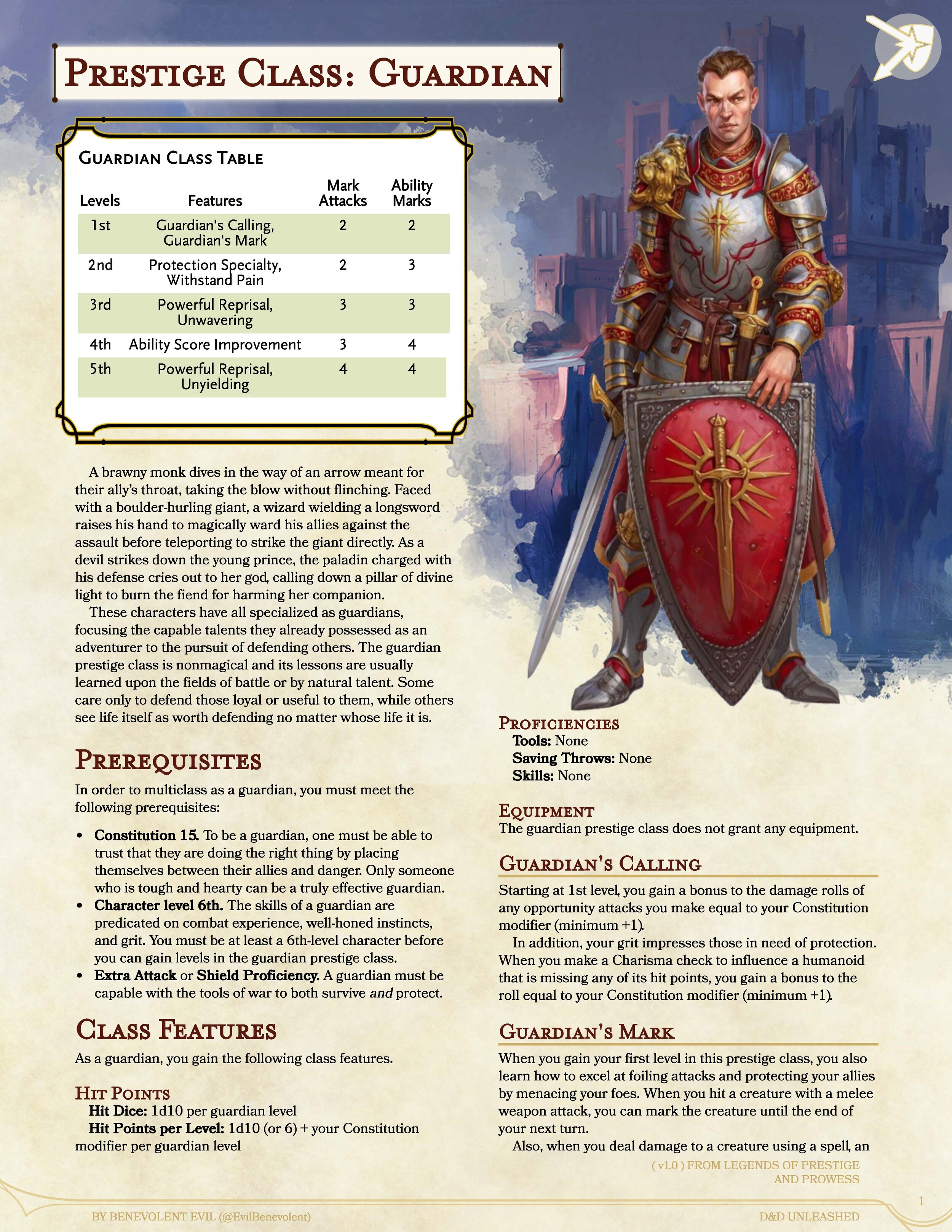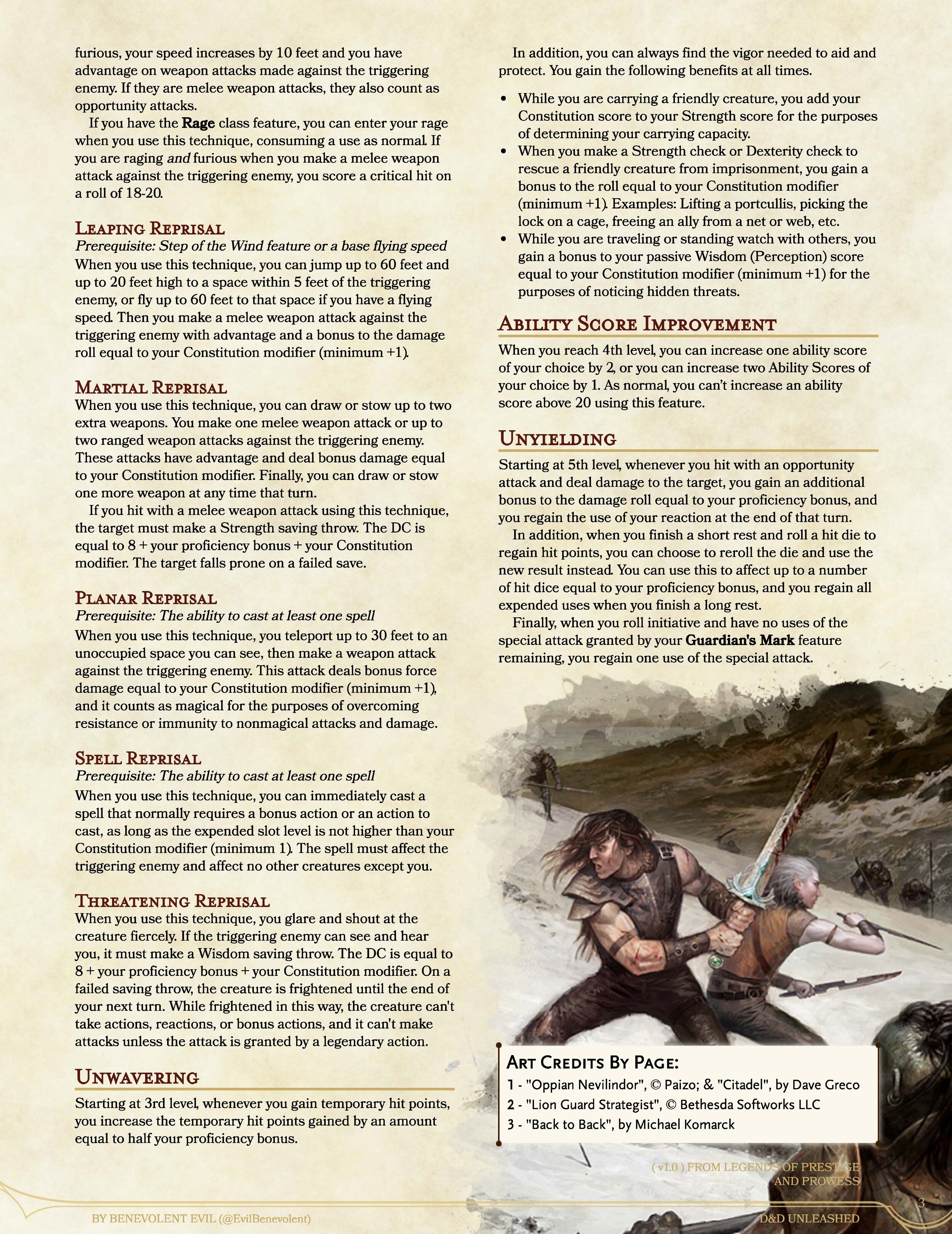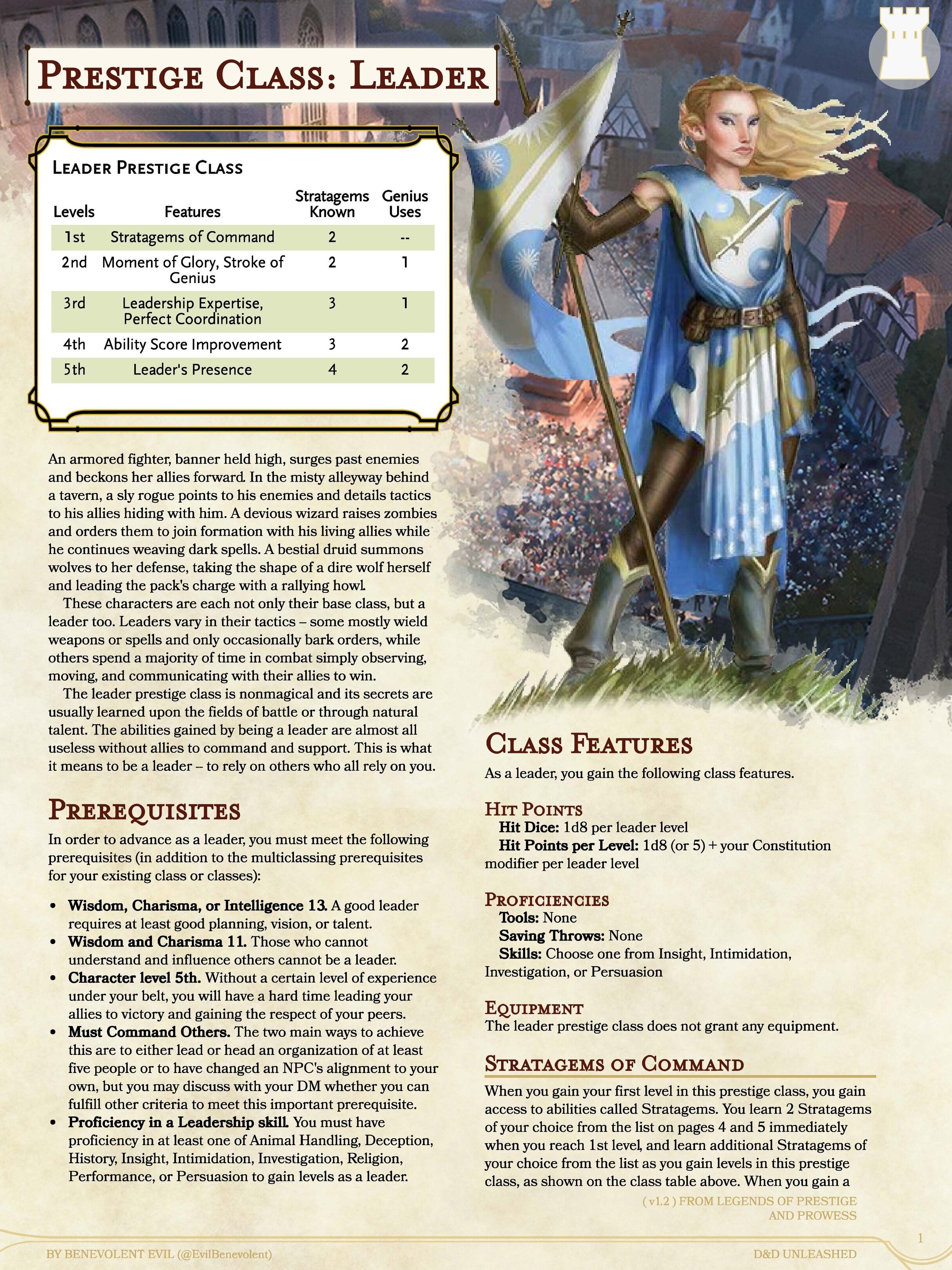The Guardian (Prestige Class)
“I'll cover your back, the sharp and bloody way.” — Jean Tannen



PDF Link | D&D Beyond Links: Shield Other
Whether using a blade, a shield, a spell, or a prayer, many warriors in fiction strive to protect those they care deeply about, those that are useful to them, or those who just don’t deserve to be hurt. Whether they’re a knight, a superhero, a mercenary, a parent, or something else, these characters — despite their diverse base classes — are also all Guardians.
The Guardian prestige class is designed to transform a warrior of any stripe into a sentinel of defense, ready to take hits for their allies, weather the blows, and punish enemies who choose a different target. It’s heavily based thematically on the design of many of the Defender-role classes in 4th edition D&D, but mechanically premised mostly on the Cavalier fighter subclass (from Xanathar’s Guide) in 5th edition. The guardian answers the question many tough PCs find themselves asking — “but why should the enemies try to attack me and not the healer?” The intent is to enable a PC to specialize in the role of defending their allies from harm in a unique way that fits their class (or multiclasses) and feels like an extension of their existing character concept without requiring a new subclass for each possible class. This also leaves room for more specific subclasses to be used with the style of defender-role combat, which helps open up themes that could be reached in 4th edition but otherwise not in 5th edition, such as the Swordmage or the Warden. Of course it can also be combined with subclasses that are already more defensive, such as in the case of the Templar, which creates a character that nearly lives and breathes to defend their allies.
Design-wise, the guardian places a great deal of power into its reaction, and expects to be frequently using its reaction, especially at higher levels. This can be a great benefit to some builds that don’t use their reaction much, but it also limits the power granted by the guardian class features from getting too out of control. Even the level 5 feature which greatly expands the guardian’s ability to use their reaction still limits them to one usage per turn, and that requires a great investment of levels. As is usually the case with prestige classes, the added potential for build synergy and powerful combos is generally balanced out by the amount of character power one misses out on for investing heavily in a prestige class. 5 levels off of a fighter usually means an entire extra attack. Off of a barbarian, it often means fewer rages and less damage, plus missing toughness features. Off of a full spellcaster, it means two and a half spell levels missing — when other spellcasters are casting 7th level spells, you’ll still be casting 4th-level at best! And for nearly every class, 5 missing levels usually means the loss of two (or sometimes only one) subclass features, which can be very powerful features to miss out on for certain classes like the paladin or artificer. This isn’t to say that the levels invested in guardian aren’t worth it — on the proper builds, they certainly can be! But like any multiclass, it isn’t free power.
Each Prestige Class is a dedicated multiclass — they cannot be a character’s base class, and instead have to be multiclassed into. For that reason, if a DM or group dislikes or disallows multiclassing, they probably shouldn’t play with prestige classes. The new combinations allowed by these prestige classes can be very powerful, but they are no more powerful than the combinations already allowed by multiclassing.
Note that shield other appears for the second time here. It’s had its bonus to AC increased from +4 to +5, so that it matches the default shield spell.
In Fiction
There are a number of great examples from fictional media of characters that could or should be built as guardians, and they serve to help illustrate the themes of this prestige class. These are just a small selection:
Captain America: Though he’s also likely got levels in the Leader prestige class, there’s no doubt that he’s also a perfect example of a guardian. Cap’s frequently known for employing Sacrificial Dive when just using the Protection fighting style with his iconic shield isn’t enough to save someone. And he’s definitely got the added toughness from Withstand Pain, not to mention the bonuses from Unwavering fit perfectly with the enhanced attributes gained from the super-soldier serum. The combination with leader can work surprisingly well if combined with the right stratagems, despite being highly level dependent and requiring some seriously split attributes.
Mikasa Ackerman: Mikasa is known for her nearly peerless skill with the two blades wielded by the soldiers in the Attack on Titan (Shingeki no Kyoujin) series, and while you might build her with a level or two of ranger along with the certain levels in fighter, there’s also few better examples of a guardian who stops at nothing to defend those that are close to her. Furious Reprisal and Threatening Reprisal are definite selections for replicating Mikasa’s vengeful reactions and penetrating glares.
Daryun (Arslan Senki): This plate-armored spearman is known for his determination to fulfill his sworn oath and duty (protecting the Prince, Arslan), and for suddenly appearing like an omen of death above anyone who threatens the prince. Though he’s known for his impeccable spear technique, he only reaches the true pinnacle of performance when the prince or someone else he cares about is threatened with danger. He’s almost certainly sporting Furious Reprisal, and based on his spear-throwing capabilities, maybe Martial Reprisal too! Of course, with some of his scary glares, he might have Threatening Reprisal instead!
Jean Tannen: First appearing in The Lies of Locke Lamora, Jean is known both by fans and by those in-universe as a veritable sentinel in regards to the titular character, Locke (who we previously described as a Tactician). With a fierce rage inside and wielding two hatchets as his weapons of choice (when he isn’t bashing people’s faces with his fists or knees), Jean’s base class is up for some debate. Is he a tough rogue? Is he a scoundrel-y fighter? Is he a barbarian? Some combination of the three? One thing’s for sure, though. When you threaten Locke Lamora, Jean Tannen appears, and as a man known for his fury, he’ll probably be boosted by Furious Reprisal when he’s breaking and smashing you the next turn.








